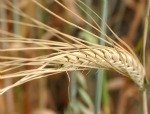Wheat Allergy vs. Gluten Intolerance and Celiac Disease

Wheat allergy is a relatively rare condition. But the wheat itself contains many allergens already identified. It develops mostly in infants and toddlers. Most kids outgrow it by the age of 3-4.
Wheat allergy can be a food allergy or a contact allergy. Contact variation of this allergy tends to spike in spring when the air is filled with pollens. This allergy is mostly spread among workers of wheat industry.
Food variation of the allergy shouldn’t be confused with gluten intolerance and celiac disease. Food allergy is a condition when the immune system treats a food component (mostly proteins) as a foreign body and releases antibodies (Immunoglobulin E) to fight it. This causes allergic reactions. Visit Allergies section to read more.
Gluten intolerance and celiac disease are NOT allergies. They are autoimmune disorders. Gluten is a protein in wheat. Here is what happens. The immune system attacks the body itself (the intestines) in response to gluten. This causes mal-absorption of many vital nutrients. No antibodies are produced. Visit gluten/celiac section to read more.
The bottom line is: gluten-intolerant people can’t have wheat (it contains gluten), but wheat-allergic people may be able to consume gluten (if allergic reaction is caused by wheat components other than gluten).
Wheat Allergy Symptoms:
- Hay fever
- Asthma
- Eczema
- Gastric distress
- Hives
- Throat swelling
- Skin swelling
- Rash
- Watery eyes
- Nasal congestion
- Nausea
- Vomiting
- Crampy abdominal pain
- Diarrhea
- Obstructed breathing
- Anaphylactic shock (collapse)
Anaphylactic shock (collapse) is a very severe life-threatening allergic reaction. Symptoms develop very fast and medical assistance should be sought immediately.
Most common symptoms are swollen face and throat, hives, abdominal pain, vomiting, diarrhea, low blood pressure. First aid should be an adrenaline injection. If your baby had anaphylactic shock as an allergic reaction to wheat, analyze his/her surroundings carefully to eliminate potential triggers. Avoid wheat going forward.
If your baby’s lips, tongue, face are swollen, and he/she has trouble breathing or swallowing, call 911.
Breastfeeding and Wheat Allergy
If you have a family history of allergies or if a wheat allergy is suspected in your baby, breastfeeding is a must.
Our immune system treats every object that comes in contact with us as a foreign body. As our immune system matures it learns to accept most of the “foreign” bodies. So if your baby is prone to allergies, the later he/she comes in contact with a potential allergen, the better the chances that the immune system will react normally to it.
Since most allergies are outgrown, by breastfeeding your baby for as long as you can, you increase his/her chances of living allergy-free!
Allergy to wheat can be tested with a blood or a skin test. You
can also try an elimination diet if you notice allergy symptoms in you or
your baby. Try eliminating wheat products for two- three weeks and see if the
symptoms go away. If they do (and they were not severe), try re-introducing
wheat into your diet. In cases of severe life-threatening symptoms, don’t
re-introduce wheat. Talk to your doctor. Visit Allergy Testing section to read more.
Your doctor will probably recommend you carrying an EpiPen (an epinephrine auto-injector), if your allergic reaction is severe.
Wheat Allergy Fact Sheet
If you or your breastfed baby is confirmed to be allergic to wheat, here is what you need to consider:
- Avoid wheat-containing breads, cereals, pastas, baked goods, candies, chocolate, spreadable cheeses, chips (even potato), desserts
- Food-thickeners (used in canned fruit, meats and stocks; dressings, gravies, sauces, marinades) may contain wheat
- Processed meats may contain wheat
- Kamut, spelt, bulgur, durum, semolina, wheat germ, wheat bran, cracked wheat, malted wheat (process used to develop enzymes), graham flour are wheat products
- Triticale is a blend of wheat and rye
- Buckwheat is NOT a wheat product
- Vegetable protein is made from grain
- Some medications and vitamins may contain wheat starch
- Battered, bread-crumbed and coated meat and seafood dishes contain wheat
- Many alcohol drinks (beer, ale, gin, wine, vodka) contain
wheat. Another reason to stay alcohol-free while breastfeeding. More about alcohol consumption while breastfeeding in Food Avoidance section.
- Flavor enhancer MSG (Monosodium Glutamate) is a source of wheat too!
The bottom line is: read the labels carefully. Many foods that seem wheat-free contain wheat. Be careful when eating out.
There are many foods in stores today made with wheat substitutes. You can consume foods made with potato, tapioca, arrowroot, rice, corn, soy, barley, oat and buckwheat flour and corn and sago starch.
And don’t get discouraged from breastfeeding your little one. Switching to formula will make your life a little easier in terms of diet, but will deprive your baby of a chance to live without allergies. Living wheat-free is doable! Read my story here. Keep on doing a great breastfeeding job and be proud of yourself!
There are many ways to show your love and devotion to your kids and to win their trust. Breastfeeding is the most natural one.
Yours,
Viktoriya
Back to top of Wheat Allergy>Food Allergies>Breastfeeding Home










